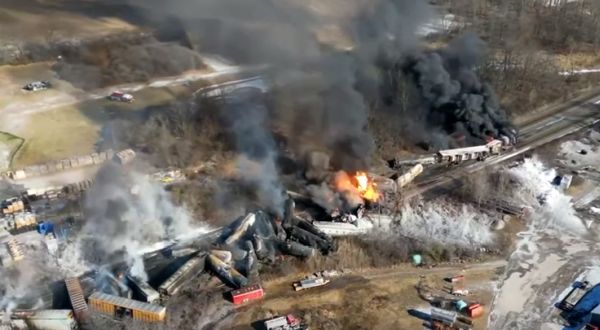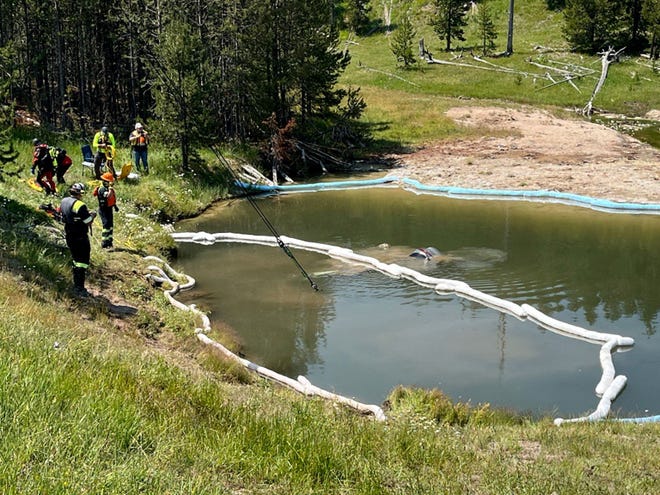Ohio Train Derailment: The Long-Term Impact Of Lingering Toxic Chemicals On Buildings

Table of Contents
Contamination Pathways and Building Materials
The toxic chemicals released during the Ohio train derailment can contaminate buildings through several pathways. Understanding these pathways is critical for effective remediation and preventing further health risks. Specific chemicals of concern include vinyl chloride, a known carcinogen, and butyl acrylate, an irritant. The porosity and composition of building materials significantly influence the extent of contamination.
-
Airborne deposition of particulate matter containing toxins: Fine particles carrying toxic chemicals can settle on building surfaces, penetrating porous materials like wood and brick. This is especially true for materials with a high surface area.
-
Water contamination leaching into building foundations: Rainwater and groundwater can become contaminated with spilled chemicals, leaching into building foundations and potentially seeping into basements or interior spaces. This poses a significant risk for long-term contamination.
-
Direct contact with spilled chemicals affecting exterior surfaces: Buildings located near the derailment site may have experienced direct contact with spilled chemicals, leading to surface contamination and potential damage to exterior materials such as siding, roofing, and windows.
-
Potential for chemical absorption into building materials (wood, brick, etc.): Many building materials are porous and can absorb toxic chemicals, leading to long-term contamination that is difficult to remove. This absorption can lead to "building material degradation," weakening the structural integrity of the building over time. The extent of absorption depends on the material's properties and the concentration of the toxic chemical.
Assessing and Mitigating the Damage
Assessing the damage to buildings following exposure to toxic chemicals from the Ohio train derailment requires a multi-faceted approach involving environmental testing and thorough inspections.
-
Environmental testing to identify the presence and concentration of contaminants: This involves taking samples of air, water, soil, and building materials to determine the types and levels of toxic chemicals present. Advanced laboratory techniques are needed for accurate analysis.
-
Visual inspections for signs of damage (discoloration, cracking, etc.): A visual inspection can identify obvious signs of damage, such as discoloration, cracking, or deterioration of building materials. This provides preliminary information to guide further testing.
-
Material testing to determine the extent of chemical penetration: Testing building materials like wood, brick, and concrete can reveal the depth of chemical penetration and the extent of damage. Specialized equipment and techniques are necessary for this.
-
Utilizing specialized equipment for detection: Specialized equipment such as gas chromatographs and mass spectrometers are often used to detect and quantify volatile organic compounds (VOCs) and other toxic chemicals.
Remediation strategies depend on the severity and extent of contamination. They range from simple cleaning and decontamination procedures to more extensive measures, such as demolition and rebuilding. The process requires the expertise of certified environmental specialists experienced in "hazardous waste removal" and "building remediation."
Long-Term Health Risks Associated with Contaminated Buildings
Exposure to lingering chemicals in contaminated buildings presents significant long-term health risks to residents and building occupants. These risks can be severe and long-lasting, requiring careful monitoring and mitigation.
-
Respiratory illnesses: Inhalation of airborne contaminants can lead to various respiratory problems, including asthma, bronchitis, and other lung diseases. The severity depends on the concentration and type of chemical, as well as the duration of exposure.
-
Skin irritations and allergies: Contact with contaminated surfaces can cause skin irritations, rashes, and allergic reactions. Some chemicals can trigger severe dermatological conditions.
-
Neurological problems: Certain chemicals can affect the nervous system, leading to neurological problems ranging from headaches and dizziness to more serious cognitive impairments.
-
Cancer risks (long-term exposure): Exposure to carcinogens like vinyl chloride can significantly increase the risk of developing various types of cancer. Long-term monitoring of residents is critical to identify potential health issues promptly.
Ongoing monitoring and transparent communication with residents are essential to mitigate these risks and address "public health concerns."
Legal and Insurance Implications
The Ohio train derailment presents complex legal and insurance implications for property owners in the affected area.
-
Legal recourse for property owners facing contamination: Property owners may have legal recourse against responsible parties for property damage and remediation costs. Environmental law will guide this process, potentially involving litigation.
-
Insurance coverage for remediation and related costs: Insurance policies may cover some or all of the costs associated with remediation and related expenses. However, the coverage may vary depending on the specific policy and the extent of the damage.
-
Potential liability for property owners in cases of negligent handling of contamination: Property owners have a responsibility to manage contamination safely and may face liability for negligent handling.
Navigating these legal and insurance processes requires careful consideration of "environmental law," an understanding of "property damage" claims, and the assessment of potential "legal liability." Professional guidance is essential.
Conclusion:
The Ohio train derailment’s impact extends far beyond the immediate aftermath, leaving a lingering threat in the form of toxic chemicals affecting buildings in the surrounding area. Understanding the contamination pathways, effectively assessing the damage, mitigating the risks, and addressing the legal and insurance implications are crucial steps in ensuring the long-term health and safety of the community. Addressing the long-term effects of the Ohio train derailment requires immediate action and comprehensive strategies to prevent further harm and provide support for affected residents. Ignoring this issue could have devastating consequences. We must actively monitor the situation and take proactive steps toward a complete assessment and remediation of affected buildings. Act now and learn more about the lasting impact of the Ohio Train Derailment on buildings in your area. Contact your local authorities and environmental experts for further information and support.

Featured Posts
-
 Nina Earl Westbrook Wife Of Russell Westbrook Biography Career And Family
May 05, 2025
Nina Earl Westbrook Wife Of Russell Westbrook Biography Career And Family
May 05, 2025 -
 Lizzos Stunning Concert Look Cinched Waist And Curves Steal The Show In La
May 05, 2025
Lizzos Stunning Concert Look Cinched Waist And Curves Steal The Show In La
May 05, 2025 -
 Seven Killed In Yellowstone Area Truck And Van Collision
May 05, 2025
Seven Killed In Yellowstone Area Truck And Van Collision
May 05, 2025 -
 Review Dope Girls A Bold Reimagining Of World War I
May 05, 2025
Review Dope Girls A Bold Reimagining Of World War I
May 05, 2025 -
 Ufc Fight Night Sandhagen Vs Figueiredo Predictions And Best Odds
May 05, 2025
Ufc Fight Night Sandhagen Vs Figueiredo Predictions And Best Odds
May 05, 2025
